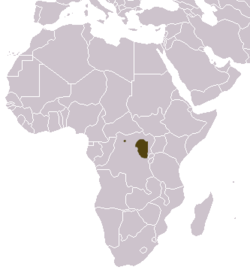Aquatic genet
| Aquatic Genet[1] | |
|---|---|
| Conservation status | |
| Scientific classification | |
| Kingdom: | Animalia |
| Phylum: | Chordata |
| Class: | Mammalia |
| Order: | Carnivora |
| Family: | Viverridae |
| Subfamily: | Viverrinae |
| Genus: | 'Genetta' |
| Species: | ''G. piscivora'' |
| Binomial name | |
| Genetta piscivora (Allen, 1919)
| |

| |
| Aquatic genet range | |
The aquatic genet (Genetta piscivora) is a carnivoran mammal located in forests of the northeastern region of the Democratic Republic of the Congo. Its range extends from the northeastern bank of the Congo River to a rift extending across eastern and northeastern Congo.[3] They are the one of the least known and rarest Viverrids to be seen in the wild.[3] The aquatic genet is related to civets and linsangs. This species was formerly placed in its own genus, Osbornictis. However, Osbornictis has now been demonstrated to be the same genus as Genetta.[1]
Description
[edit]Unlike other genets who have spotted coats and ringed tails, the aquatic genet has a plain, rust-colored coat and a black, non-ringed tail, with white spots between its eyes.[3][4] The fur is long and dense, especially on its tail.[4] Males typically weigh 3.1 pounds, while females typically weigh 3.3 pounds.[4] Its poor sense of smell is expected in an animal descended from terrestrial ancestors that specializes in catching aquatic prey.[3]
Like most members of its family, it is a secretive and rarely seen species, and little is known about its behavior in the wild, other than that these animals do not live in groups or families.[4]
Diet and Habitat
[edit]This unusual genet inhabits rainforest[2] and feeds primarily on fish,[3] which it catches using its feet. The lack of hair on the palms and soles of their feet allows for easier fishing[4] This genet also uses its whiskers to feel the surface of the water for prey. This carnivore consumes frogs and similar aquatic prey.[4]
Reproduction
[edit]Although these animals have not been extensively studied, it is thought that the females care solely for their young. Males have no role in the raising of the young. Because most viverrids are altricial at birth, they are cared for by the female in a nest or a den. Mothers provide milk for their young. After they are weaned, the mothers often bring prey they have hunted to their young.[3]
Status and Threats
[edit]The conservation status of this genet is data deficient, but it is suspected to be "among the rarest of African carnivores".[2] A possible major threat to this species is habitat loss due to mining and logging.[3]
References
[edit]- ^ Jump up to: a b Template:MSW3
- ^ Jump up to: a b c Template:IUCN2008 Database entry includes a brief justification of why this species is of data deficient
- ^ Jump up to: a b c d e f g Roosenberg, A. 2004. "Genetta piscivora" (On-line), Animal Diversity Web. Accessed December 03, 2011 http://animaldiversity.ummz.umich.edu/site/accounts/information/Genetta_piscivora.html.
- ^ Jump up to: a b c d e f Jakowska, S. (2011). Genets. Retrieved September 30, 2011 from http://science.jrank.org/pages/2995/Genets.html

